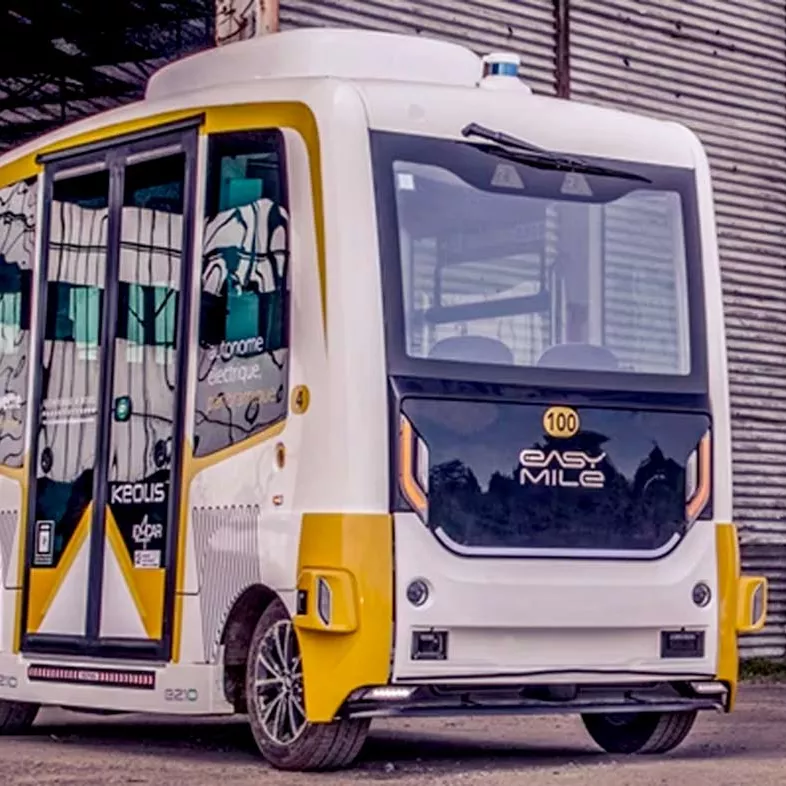Autonomous mobility : a positive supply shock in public transport
Keolis is a pioneer in autonomous vehicles, developing ever-better solutions to meet mobility needs. Find out what we’re working on, what challenges we’re facing, and how we’ll promote acceptance of autonomous vehicles in this interview with Éric Callé, our Innovation & Industrialization Director.

What progress has Keolis made on autonomous mobility?
When we began experimenting with autonomous vehicles a few years ago, they were viewed as a disruptive technology to be explored across a range of use cases. Which we did, with low-capacity shuttles.
And today?
We’re now focusing primarily on the possibility of easy service in thinly populated suburban and rural areas, and even in city centres. In all of these places, demand for public transport is limited, but people still need to get around. Bottom line: we want to use autonomous mobility to complement available public transport—late at night, for example, or during slack periods—at a competitive overall cost. This should grow public transport’s market share.
Where have you trialled this?
From 2018 to 2020, we set up a rural transport solution in the Brussels suburb of Waterloo, and a city-centre service in Nevers, France, during the holiday shopping season. In 2021, we launched a service in Saint-Quentin-en-Yvelines, outside Paris, with shuttles circulating between the commuter rail station and local business districts. In essence, we want to be part of a ‘positive supply shock’ in public transport. To do that, we’re working to automate larger vehicles and boost performance.
Would that include your autonomous minibus project?
Yes. Our Mach2 project, a pilot for autonomous public transport service in Châteauroux, in central France, is the most promising right now. It’s backed by a consortium made up of Keolis, EasyMile, Renault, Alstom, Equans and Statinf, and it should be operational in 2026. The goal is to operate 6-metre buses with around 20 seats on public roads in the city centre. That means our minibuses will be in traffic with cars, buses, and so on.
What kind of planning will that take?
We’re going to apply for permits under France’s Mobility Act (LOM)—authorizations that have never been requested or granted before. As part of that process, we’re working with STRMTG, France’s national safety agency for ropeways and guided transport, which also regulates light rail. They issue the authorizations we’ll need to create a network of road-based autonomous vehicles.
What’s the outlook for development?
We expect to have 100-500 autonomous services up and running in France by 2030. But in the meantime, we need to address a number of technical issues. How will the vehicle perceive its environment? How fast can it go? How will it react to the vehicles around it? How will it talk to the infrastructure? And so on. The first step is for the industrial players to make progress. That includes EasyMile, Gaussin-Macnica-Mobility (GAMA), Renault, Bluebus, Karsan and ZF.
What about Keolis?
We’re focusing on our autonomous mobility test site (SEMA), which we use for trials and validation work. At SEMA, we can support technology development, explore the passenger experience and lay the groundwork for deployment. The technical side of autonomous mobility is critical, and safety is the first priority.
How are you tackling that challenge?
We’re starting to set up Level 4 services, which run without a physical operator onboard. But they’ll only attract passengers if we can make everyone feel safe. A family travelling in the afternoon is one thing. A young woman boarding an autonomous vehicle alone after 22.30 is another.
They’d have very different perceptions.
Simply saying that we’re going to offer complementary service won’t get more people to take public transport. They need to feel comfortable with the vehicle we’re offering. It would be easy to make a cold, highly automated vehicle, but our vision is completely different.
Passenger experience is the key?
Exactly. That’s the purpose of our Thinking Like a Passenger programme. We’re imagining the services of the future with support from Kisio, a Keolis subsidiary. We’re asking questions such as how to welcome passengers aboard and how to interact with them, so passengers understand exactly what’s happening in a vehicle without a human driver onboard. We want to help people move away from private cars, and we hope this programme will help.
Can autonomous mobility replace private cars?
With a range of options at carefully calculated costs, autonomous vehicles should be able to offer targeted service in areas where cars are the only alternative to walking. Active people could get rid of their second car, and seniors who can no longer drive could still get around.
And make single-occupant cars¹ a thing of the past?
Yes. But to reach that goal, we need to focus on all 5 factors identified by Aurélien Bigo, a researcher who specializes in green transition for the transport sector: demand for transport, the modal shift, vehicle occupancy rates, energy efficiency, and the carbon intensity of energy. The single-occupant car is still the default solution—it’s been promoted for decades.